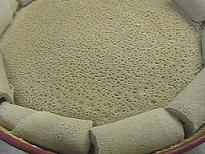Teff is a cereal crop cultivated as a source of food primarly in the Horn of Africa countries Ethiopia and Eritrea. Teff seed flour is used to make a staple bread, called injera, in both countries. Teff is an Amharic word, the Ethiopian official langauge. In Eritrea, it is called taf.
Teff seed is very small, 1–1.7mm long and 0.6–1mm wide. Its seed color ranges from milky white to black, but common colors are white, red and brown. People in Ethiopia and Eritrea pay higher premium for the white teff than darker types.

Nutrional Values of Teff
Teff is a nutritionally rich grain, comparable or even better than wheat, barley and maize in some aspects. A 100 grams teff grain contains on average 9 - 15 grams of protein, 73 grams of carbohydrate, 2 grams of fat, and 3 grams of fiber. It contains balanced levels of essential amino acids such as leucine, phenylalanine, valine, isoleucine, threonine and lysine (listed in high to low order). The only amino acid missing in teff is lysine.
Compared to maize, teff has less fat and energy content but more or less the same amounts of protein, carbohydrate, and fiber. Teff has higher tryptophan but lower phenylanine, valine, tyrosine, leucine and threonine and vitamins thiamine, niacin and riboflavin than maize.
Teff is also rich in minerals such as potassium (401mg), phosphorus (378 mg), magnesium (170 mg), calcium (159 mg) and iron (5.8 mg), all per 100 gram grains. Vitamins in teff seed include vitamin C (88 mg), niacin (2.5 mg), vitamin A (8 RE), thiamin (0.30 mg), all per 100 grams of grain. Teff grain has higher calcium (2200%), manganese (1300%), copper, potassium, and phosphorus.
In Ethiopia, teff is a major source of dietary iron, which explains for the low incidence of anemia among Ethiopians. According to many analyses, teff has higher iron content than other cereals, eg. maize. However, some studies indicated that the high iron content in teff may be because of soil contamination rather than innate iron in the grain. The same studies also concluded that iron content in pure teff grain is actually not higher than other cereals such as sorghum, maize and millet.
What makes teff grain even more beneficial to health is the fact that it is a gluten free food. Gluten is a protein that causes allergic reactions to some people. People with celiac disease cannot tolerate gluten, therefore teff grain, a gluten free cereal, is an alternative to wheat, rye and other cereals. For this reason, teff is gaining attention in the US and European health food markets. In the US, commercial farmers in Idaho and Oklahama have been growing it to satisfy the growing demand from people seeking gluten free diet and Ethiopian and Eritrean food consumers.
On the next page is list of nutrients and estimate of their content in teff.



